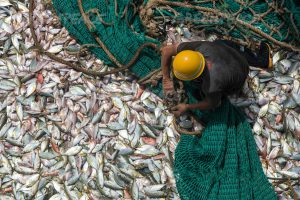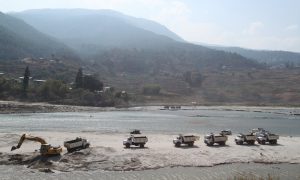Pakistan is the world’s largest exporter of groundwater through its grains export. India is the third largest. Going by per capita availability, Pakistan is almost a water-starved country. The parts of India from which most grains are exported are seriously water-scarce.
In 2010, Pakistan exported grains that had cost 7.3 cubic kilometres of groundwater to grow. India exported grains that cost it three cubic kilometres to grow. India is also the world’s largest extractor of groundwater. In 2010, 75 cubic kilometres of groundwater were extracted in India.
The trifecta of groundwater depletion for water-intensive crops, grain exports and the use of electricity for mining groundwater add up to a perfect recipe for disaster. Climate change impacts are worsening the situation.
The recent report that the new government in (Indian) Punjab has sought New Delhi’s permission to sell excess electricity to Islamabad has been welcomed in power-starved Pakistan. But this electricity will do much more than keep Pakistanis cool during the torrid summer. It will accelerate groundwater pumping in India. Not just precious groundwater, India and Pakistan are also effectively exporting energy when they export grains.
Surface water and soil moisture also play big roles in agriculture. Many countries save this water by importing grains. For those who do not, such thoughtless export of groundwater should be the biggest worry, because the timescales for recharging groundwater are significantly longer than those for surface water and soil moisture.
The sobering numbers on groundwater depletion and international food trade have been reported in the journal Nature by Carole Dalin and colleagues. About 11% of all groundwater depletion over the planet is involved in international food trade. Over two-thirds of that depletion is by Pakistan, the US and India.
Food-water-energy nexus
This food-water-energy nexus becomes critical in South Asia. On the one hand, water availability is already more uncertain due to climate change. On the other, there seems to be no accounting for the energy export through agricultural export, though both India and Pakistan are energy deficient countries. Though India has a huge renewable energy development plan, both countries also have major plans to generate energy from coal. That can only worsen the climate change situation.
Other unintended consequences of groundwater depletion include land subsidence and saltwater intrusion in addition to potential loss of soil health.
Global food supply chains are becoming more susceptible to the effects of climate change. According to the Intergovernmental Panel on Climate Change, one effect is a rise in intensity and frequency of storms. The Philippines has faced an increasing number of typhoons in recent years. Whenever one takes place, it affects food packaging around the world, because the Philippines is a supplier of coconut based food packaging material to almost all other countries.
Groundwater depletion in India
In India, wheat accounts for 35% of the total groundwater depletion and rice for about 25%, while fodder, cotton and sugarcane make up the rest. Average groundwater consumption to grow one kilogram of wheat is 812 litres, rice 200 litres (because it is far more dependent on surface water) and maize 72 litres, respectively. In the 2016-17 financial year, India is estimated to have exported 300,000 tonnes of wheat, 10.7 million tonnes of rice and 700,000 tonnes of maize.
When considering grain exports, it should be noted that the actual water exported is what is embedded in the grains themselves. This is much smaller than the total water used to grow crops, of which a small fraction of the water used in growing crops is recoverable – as it seeps back down to the water table. A much larger amount of water expended is simply lost to evaporation. This loss drives down groundwater tables, and is key to understanding how water intensive crops affect groundwater in a region. Thus the water footprint is critical to monitor as far as food exports are concerned, especially for countries like India and Pakistan that face persistent domestic and international water conflicts.
Even the embedded water approach employed by Goswami and Nishad points out that India exports a total water of around 25 cubic kilometres in food exports (not separated into surface and groundwater). The bad news is still that the near self-sufficiency in food production comes with a penchant to export some of it with hard-to-estimate externalities like groundwater depletion and salinization as well as degradation of soil health and the environment.
Exports of meat, sorghum and fruits are significant additional factors. India is also among the largest beef exporters and beef is easily the most water- and grain-intensive food group per calorie. International food trade is a reality of a global economy and India has no choice but to partake in it. But the unintended consequences in the food-water-energy nexus can be ignored only at grave risk to national security.
State-level disparities
Additional related factors for India are state-level disparities in groundwater depletion. Dry regions of Gujarat and Karnataka are exporting waters to wet regions of the country to satiate the thirst of those who can afford bottled water and soft drinks. India’s middle class continues to grow and its taste for meat and fish continues to place greater demand on water and fodder.
India has taken bold steps to be part of the global community in combating climate change by committing to impressive Nationally Determined Contributions to control carbon emissions. Equally bold steps are being taken in terms of investing in renewable energy like solar and wind. India must track the energy-intensity of its GDP and the carbon-intensity of its energy production.
But it is clear that India must also be vigilant about the groundwater-intensity of its food production as well as the groundwater and energy exports incurred by its grain and meat exports. For its economic growth and development to be sustainable, unintended cascades in the food-water-energy nexus must be diligently avoided.
![<p>The use of standing water to grow rice in India and Pakistan leads to large water loss [image by sandeepachethan/Flickr]</p>](https://dialogue.earth/content/uploads/2017/05/agricultural-fields.jpg)







